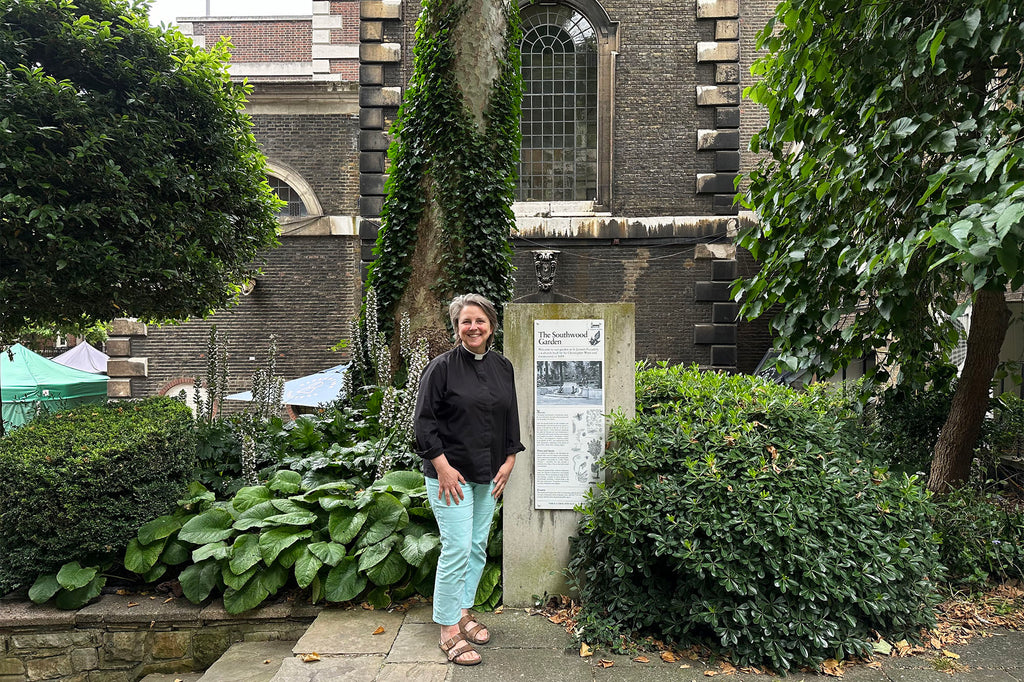Secret Gardens: Reverend Lucy Winkett at St James’s Piccadilly reflects on the RHS Chelsea Flower Show
Posted by SECRET GARDENER

We visited the garden at St James’s Piccadilly at the start of July to speak to Reverend Lucy Winkett (pictured above), following the success of 'St James’s Piccadilly: Imagine the World to be Different,' a show garden designed by six-time RHS Chelsea Flower Show gold medallist, Robert Myers, for the show earlier in the year.
It’s the start of July and the weather in London is beginning to pick up (a far cry from showery May, when it rained the entire day we visited the RHS Chelsea Flower Show). To the side of St James’s lies a hidden garden, cloaked in the shade of the tall plane trees which have kept watch over the site since the early 1800s. We walk up the steps to the grassy lawn to meet Lucy, discuss how St James’s Church has got on since the flower show and find out what’s next for the church garden.

St James’s distinctive red brick building (whose interior was recently used as the set for a wedding scene during the second series of Netflix’s Bridgerton) was designed by Sir Christopher Wren and consecrated in 1684. Wren was working on St Paul’s Cathedral at the time and rebuilding the City of London after the Great Fire of 1666. About St James’s in particular, “he thought it may be found beautiful and convenient, which doesn’t mean what it means today,” Lucy explains, “it means well placed, well proportioned and in the right place. It’s often an assumption that this was one of his favourite churches because he didn’t have the constraints of rebuilding the footprint of a church that had burned down, and he could do what he wanted.”
Aptly named, then, is St James’s vision for the future, The Wren Project, which looks to restore and completely rejuvenate the garden, courtyards and church, and open up the site to the south and east, including construction of a new archway to connect Piccadilly with Jermyn Street. A large project like this understandably has many interlocking layers to its planning and iterations of design which have taken decades in the making, but it is confidently steered by Lucy, who speaks with a calm confidence and a wealth of knowledge about the project and the influential figures who have made St James’s what it is today.

The complexity of The Wren Project involved seeking many permissions from both planning and faculty. With patience and determination the team behind the project have obtained full permissions and are now in the process of raising the funds necessary to begin the work.
As we sit in the garden, we discuss what changes are key for its future. Accessibility is one of the main reasons for the renewal of the garden. “We’re fundraising to make this garden accessible to anyone who uses a wheelchair without having to ask for help,” explains Lucy, “and for the whole of the site, to put lifts in and restore the church. But it’s a big number that we need to raise: 20 million pounds.” At the time of our meeting, fundraising has almost reached the halfway mark, with just over £10m to go.
‘Imagine the World to be Different:’ envisioning the future of St James’s Piccadilly at the RHS Chelsea Flower Show 2024
The ‘St James’s Piccadilly: Imagine the World to be Different’ show garden was designed by landscape architect, Robert Myers. Inspired by nature’s reclamation of old bomb sites, the garden’s theme celebrates London’s pocket parks, and is a template for the larger garden which is planned to be built at St James’s during The Wren Project. The show garden was sponsored by Project Giving Back, a grant-making charity that offers organisations in the UK the chance to have a fully funded garden at the RHS Chelsea Flower Show, tell their story and promote their cause. From its inception in 2022, the project will fund 60 gardens by 2026, all of which will have permanent homes after the show ends.
Storm Flowers Garden: How did the garden project come about and what was it like for St James’s to be showcased at Chelsea?
Lucy Winkett: The Chelsea Flower Show was a chance for us to tell the story of St James’s since 1684, and to celebrate green spaces in urban settings. The Chelsea garden represented the themes in a microcosm of what is going to happen here for The Wren Project, so we were able to show people what the vision will look like.
LW: We have some amazing historical figures who have been associated with the church; William Blake was baptised here, and an inspirational abolitionist called Quobna Ottobah Cugoano, whose story is very undernarrated. It was actually his 250th anniversary last year, so to honour this we commissioned a quartet of paintings from Trinidadian artist, Che Lovelace, to be exhibited in the church. It was a moment of reckoning, for us to face history with honesty, and talk about it as well as celebrate him. Mary Delaney (botanist and pioneering female artist), is also buried here, as well as Mary Beale (portrait artist), and James Gillray (political cartoonist).

LW: William Blake is probably the most famous of the group, but we wanted to amplify the other names and say that these people imagined the world to be different. They didn’t accept the status quo, but also importantly they worked to change it. They didn’t just have dreams; they wrote about them, or campaigned for them, or used art to call people into a different future. And we think that’s what Church is for; that’s what I believe Christianity is, it’s imagining a better future and then working in the present to make that so.
SFG: Were these figures the inspiration for the show garden’s name, “St James’s Piccadilly: Imagine the World to be Different”?
LW: Yes, it’s influenced by all the historic figures who are buried here, and whose stories are connected with the church. The people who have been associated with us here are individual, strong, creative characters, all trying to make the world a better place. It was also important for us that the garden had roots in our faith. We really believe Christianity is about what it is to be human. It’s about hope, and love, and faith. On the outside wall of the garden at Chelsea we had a quote from a former Rector, one of my predecessors, who said “the Church exists primarily for the benefit of those who do not belong to it” (William Temple, Rector 1914-1917), and that’s incredibly important to us.

SFG: What has the reaction been like from visitors?
LW: People connected quite deeply to the garden at Chelsea in a way I wasn’t expecting. I thought visitors would think they were simply coming into a garden, but for them it was a visit to a church garden, which added an interesting perspective. It was partly to do with the quote from William Temple, I think, that the Church is there for people who don’t belong to it. So people were telling us stories about their connection to this place, or their connection to Church, and their views, which were really strongly negative as well as positive.

The church was bombed during the second world war in 1940, but despite this the steadfast congregation continued to meet in the ruins. During this time some unusual plants grew up from beneath the rubble, and scientists from Kew Gardens went to St James’s to document them. There were 42 recorded ‘pioneer plants,’ such as chickweed, speedwell, and vetch, which serve as a reminder of the resilience of nature. Some of these species were featured in the planting of the garden at Chelsea.
LW: What the pioneer plants taught us is that even in the ruins, when human beings are being violent to one another, life can go on. Sometimes it’s fragile, but it’s very beautiful, and that’s what we should lean into and put our trust into, within what is still a violent world.
SFG: One of the more striking features of the garden designed for Chelsea is the sculptural timber cabin. What was that designed for?
LW: We have a counselling project in the garden, which at the moment is in the Caravan, and has been here in different forms for 35 years or so. The idea is that whoever you are, you can drop in for one hour of free counselling, and a trained psychotherapist will listen to you. And they’re open seven days a week. Mother Teresa actually blessed it, back in the 80s. For the Chelsea garden, Robert Myers worked with an artist, Ivan Morison, to design a new, round counselling facility with a really distinctive roof. We hope to bring this beautiful wooden structure, made of oak and sweet chestnuts here when we do The Wren Project. People often visit the Caravan and bring with them quite difficult experiences, often with shame, distress, and complex emotion. One of our convictions is that if you’re able to talk about it under a tree, or in a beautiful place like a garden, then it gives you room to breathe and tell that story in a way that’s different than sitting in a boardroom or across a desk, or going to a church and talking to a vicar. With the counselling project, you can tell your story without having to enter the church, to someone who’s trained and who will listen.

View of the newly designed counselling cabin through the arch at RHS Chelsea Flower Show. Photograph by Richard Bloom.
The preservation of the site’s history continues through the design of a table for the new cabin, constructed from wood from a catalpa tree which fell in the courtyard in 2010. Estimated to have been with St James’s since the 1920s, it saw a new lease of life in the form of carvings of figures from the Nativity, which are used at Christmas. Now, around 100 years since it was planted, its story continues. The fabric of the church’s past acts as material for its future, hopefully to be used in the new counselling facility.

Adjoa Andoh, Ivan Morison and Ian Burton in the counselling cabin at RHS Chelsea Flower Show. Photograph by Belinda Lawley.
Adjoa Andoh, star of Netflix’s Bridgerton which filmed in the church during its second series, is a lay preacher, and has volunteered in the Caravan Counselling Project at St James’s in the past. The Caravan Drop-in and Counselling service at St James's Church welcomes people from all walks of life. Run in partnership with the CPPE since 1982, it offers a safe, private space for more than 5,500 hours of free counselling a year.
One of the requirements for this year’s RHS Chelsea Flower Show was for the show gardens to be reused as much as possible after the end of the show, with many being relocated. For St James’s, the plants from the show garden have been planted at St Pancras Euston Road, their partner church. The timber cabin, along with plaques and other structures from the garden, remain in storage until The Wren Project commences. Sustainability was also key to the RHS, with all the gardens undertaking a ‘Green Garden Audit’ to reduce environmental footprints. St James’s garden used cement-free concrete, no peat-based materials, local suppliers and limited waste; 90% of materials used will be transported to the legacy garden at St James’s or to other projects.
SFG: Can you tell us about your partnership with St Pancras Church and how that started?
LW: This is a wonderful thing. We formed a partnership with another historic church opposite Euston station, called St Pancras. During the pandemic their congregation had gotten low, and they wanted some help, and we needed somewhere to be during our renovations, so we formed this partnership, and they’ve been really welcoming to us. Together we will gradually increase our capacity jointly to run the two parishes together. During The Wren Project, we will be closed for at least one year, so we’d need somewhere to go on a Sunday. We also have our food market, the counselling project, events and concerts, and hope to do all of that too, at St Pancras. The idea is that when we return here after the renovations, we hope that St Pancras will be rejuvenated too with a bigger, greater capacity in their congregation.
SFG: As the Rector here for over 13 years, do you have any particular memories of the garden that stand out during your time here, before it is transformed?
LW: A memory that comes to mind is that we had a joint celebration of harvest (a Christian festival), and Sukkot (a Jewish festival), some years ago. We built a Sukkah, which is a temporary shelter, in the middle of the garden. It was up for the duration of the festival, which was about 10 days. We'd had a series of events with Christians and Jews speaking together about our faith and the environment in particular, because both of those festivals are to do with the natural world. On the final night, we had a fantastic band playing in the shelter, and we had lots of dancing. I remember dancing here for that, in that shelter in the garden, it was wonderful.
SFG: Lastly, what advice would you offer to other churches looking to create a community space or rejuvenate their garden?
LW: As a society, I think we realised during the pandemic that not everyone has equal access to green space. This is an inequality that has been there all the time, but it was exposed during the pandemic because it was so needed. It was such a difficult time for so many people and for our congregation, and people’s mental health was being challenged so strongly.
I think publicly accessible green space, with trees and plants, and the chance to talk, is really important. I would encourage anybody who owns or who has a lease of any green space to make it as publicly accessible for as much of the time as possible. During the pandemic, I was the only person here and it seemed almost the only person in Central London. It was really extraordinary. I spent a lot of time in this garden with my dog, who recently passed away. I said my prayers out here rather than in the church, and it just completely changed my relationship with it.
Within a city that is very driven and focussed on doing things, it’s so important to have access to a space, not just for rest, but for connections and remembering who you are and what you want; you can make different decisions about your life in a garden.

Rev'd Lucy Winkett in front of the counselling hut in the St James's Piccadilly garden at the RHS Chelsea Flower Show.
Photograph by Belinda Lawley.
***
With thanks to Rev’d Lucy Winkett for her time and for welcoming us into the garden at St James’s.
To find out more about the Wren Project or to make a donation, visit their website https://www.sjp.org.uk/ways-to-donate/the-wren-project/

